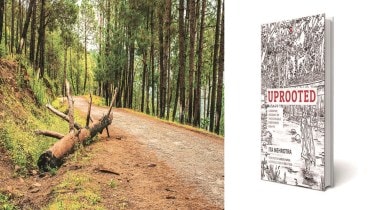By Reena Singh
Some books speak to your mind; Uprooted speaks to your conscience. Ita Mehrotra’s graphic narrative doesn’t just tell a story, it puts you in the middle of a forest clearing where the wind carries both the smell of damp earth and the weight of eviction notices. The book focuses on the Van Gujjar and Taungya communities in Uttrakhand’s Terai region—the people who have lived with the forest, not just in it, for generations. Their lives are shaped by movement of the seasons and rhythms of the forest. But when the land they’ve nurtured is declared ‘protected’—not for them but from them— their existence is thrown into question. This tension is what Uprooted captures, with compassion.
The power of visual storytelling
Mehrotra’s choice of monochrome illustrations draws attention to detail: the curve of a buffalo’s horn, the intricacies of the Van Gujjar houses, the weather lines on a woman’s face. The absence of colour almost feels like a metaphor for the absence these communities face when they are pushed out of their homes. There are panels with barely any words, just the forest or a lone figure walking with belongings piled high. Those moments of silence feel deliberate. It’s a powerful use of visual storytelling that makes the reader feel what’s left unsaid.
Amidst this quiet, she threads in the uncomfortable contradictions the people live with. Forest department officials, speaking to the media, accuse Van Gujjars of cutting down entire forests, when in reality the felling is often done by labourers brought from Kashmir. By evening, those same officials visit the deras, leaving with tins of ghee and milk. The narrative also recalls how landowners, to avoid redistribution to landless communities, have registered land in names of their animals, ancestors and even gods, which has ultimately found its way into the control of very department now policing it.
Voices of displacement and resilience
The book focuses on multiple voices, an elder recalling how the forest provided everything from fodder to medicinal plants, children dreaming of a future where a teacher comes to them, and a woman speaking of how relocation has brought rising violence against women, growing dowry demands and increased alcoholism and drug use. Their knowledge isn’t abstract, they know which leaves heal wounds, how to guide water through channels that even deer and elephants seek out in the summer, how to lop branches without harming the tree. So when they are relocated, its not just geography that changes, it’s their whole ecosystem of survival.
Mehrotra makes this point without preaching. Instead, she lets the stories speak—a family working in a small patch of land and rebuilding their home with mud bricks that trap heat in summer and cold in winter, wishing they still had the grass and palm leaves that once kept their houses comfortable; a mother worrying about her children’s education when the nearest school is far away and the plight of Taungya workers who painstakingly grew an entire forest.
The book also talks about the Forest Rights Act of 2006. On paper, it promises protection. In reality, as Mehrotra’s narrative shows, the implementation is riddled with delays, rejections, and bureaucratic hurdles. It shows how laws play out in real life with the long wait for claims to be processed, the disappointment when documents are deemed ‘insufficient’, and the sheer exhaustion of fighting the same battle year after year.
Uprooted is not just about the Van Gujjars or the Taungyas, it’s about how we conceptualise land, belonging and conservation. Too often, environmental protection is framed as a binary—preserve nature or allow human habitation. Mehrotra challenges this false dichotomy. These communities are not intruders; they are caretakers. The strength of Uprooted lies in its quiet urgency. It invites the readers to listen, to reflect and to feel these stories. It reminds us that when we speak of forests, we must also speak of the people whose lives are rooted in them.
If you care about social justice, environmental rights, or simply believe in the power of stories to open hearts, this is a book worth reading. It’ll stay with you, like the echo of footsteps on forest soil long after the walker is gone.
Reena Singh is senior fellow, ICRIER
Disclaimer: Views expressed are personal and do not reflect the official position or policy of FinancialExpress.com. Reproducing this content without permission is prohibited.
Uprooted: A Graphic Account of the Struggle for Forest Rights
Ita Mehrotra
Context
Pp 144, Rs 599
